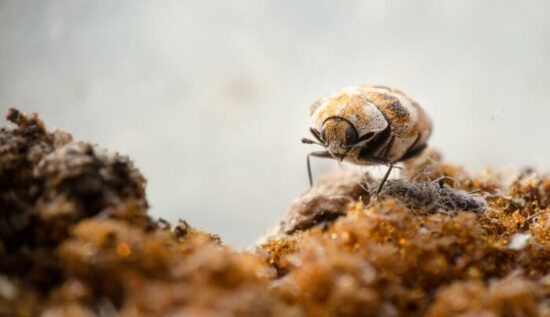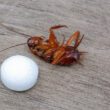Learning how to get rid of carpet beetles is a process that many homeowners have to go through. These pesky little insects can cause a surprising amount of damage, and it’s important that you stop them fast!
This guide will teach you all about carpet beetles, how to get rid of the, and ways you can prevent them from showing up in the future.
Table of contents
What Are Carpet Beetles?
When most people see holes in their clothes and blankets, they automatically assume that a moth is to blame. While moths can do a lot of damage, it can often be the work of carpet beetles.
And these are one of the most overlooked pests in your home! Carpet beetles are tiny insects that feed on organic fibers when they’re in the larval stage.
Contrary to popular belief, it’s not the adult beetles you have to worry about the most. Adults can be pests since they hang around your kitchen in search of food, but they exclusively feed on pollen and nectar.
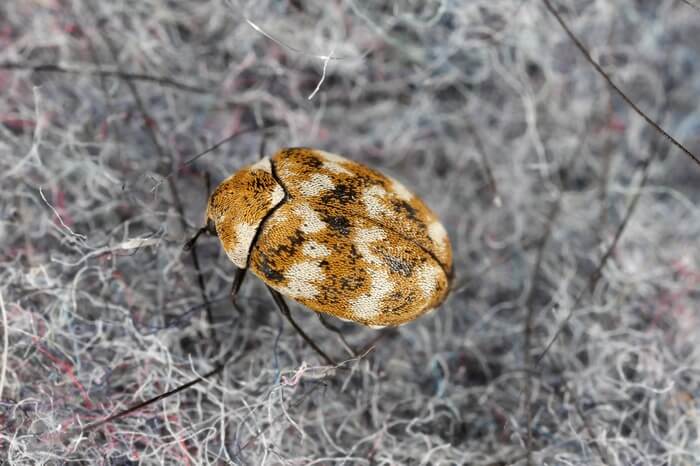
However, they will eventually go inside to lay eggs. When they do, they’ll deposit hundreds of tiny fiber-eating vermin!
These larvae are the true devils. They have an unrelenting appetite for keratin, a protein found in animal skin and hair. It’s also in natural plant fibers.
Quick Tip: Keratin is present in pretty much all the organic fibers around your home. They’re not just in carpets. Those little pest offspring will eat everything from your favorite cotton sweater to that jute rug you have sitting in your entryway!
There are several kinds of carpet beetles out there, but most of the larvae look the same. They’re grub-looking creatures with color-banded bodies. The larvae might have hues of white, light brown, and dark brown. However, they all have prickly hairs that feel sharp and irritating when you touch them.
Adults carpet beetles have a little more variety to them. There are four main species.
Black & Common Carpet Beetles
Black carpet beetles and Common carpet beetles look pretty similar. They’re oval-shaped and measure about a quarter-inch long. They’re consistently black and have six tiny brown legs.
Varied Carpet Beetle
Another common species is the Varied carpet beetles. These bugs are only about 3.5 mm long. However, they have scaly bodies covered in patches of brown, yellow, and white.
Furniture Carpet Beetle
Finally, there’s the Furniture carpet beetle. It looks similar to the Varied species. However, the body is black with a mottled pattern of yellow and white.
Signs You Have An Infestation
Think you have an infestation of carpet beetles that you need to get rid of? There are many ways to find out for sure. While carpet beetles are pretty discrete, they leave behind some telltale signs of their presence!
Here are some of the most obvious.
Live Bugs Or Larvae
The most obvious sign that you need to get rid of carpet beetles is catching these critters in the act! As mentioned earlier, larvae have a grub-like appearance. They look like tiny hairy worms working their way through whatever natural fabric they can get ahold of.
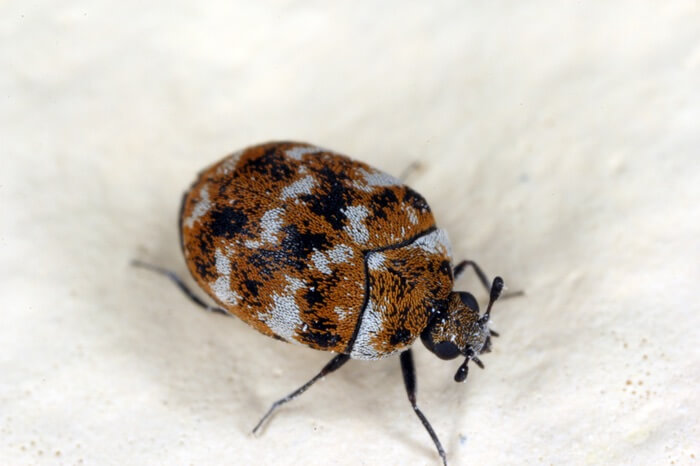
Usually, you can find them on the edges of the carpet or rugs. It’s the most straightforward access point, but you might also see them on baseboards, on upholstered furniture, or even on hanging clothes.
Quick Tip: These pests can appear just about anywhere. They’re sensitive to light, so you’re most likely to encounter them in dark parts of the home. If you’re on the hunt for physical evidence, focus your search on closets, underneath furniture, and drawers.
Don’t forget to keep an eye out for adults, too. The offspring might be the ones to ruin your fabrics, but adults can stick around as well.
The adult beetles spend most of their time outside to eat. However, they head inside the home to lay their eggs. Look around openings to spot them.
You might see them on windowsills, around baseboards near exterior doors, or stuck in window screens. Sometimes, they show up in your kitchen as well. If you have any fresh flowers in the home, don’t be surprised if you see them grazing on that nearby treat!
Eggs
Carpet beetle eggs are tiny and very difficult to see with the naked eye. That said, you can still spot them with a magnifying glass if you know how they look.
The eggs are oval-shaped and less than a millimeter long. They’re off-white or cream-colored, so they tend to stand out on darker surfaces.
Where do carpet beetles like to lay their eggs? They prefer anywhere dark and out of sight.
Search all of those dark places we discussed earlier. Under furniture, in closets, and along floor baseboards are the most common nesting spots. These pests can also lay their eggs on draping curtains, in small structural cracks, or on top of window casings and dusty shelves!
Quick Tip: Interestingly enough, they like to hijack other nests, too. These insects are notorious for using bird and insect nests to lay their eggs.
It’s easier to look for large groupings of eggs. Some carpet beetle species can lay more than 100 eggs at a time. Adult beetles don’t live that long, so they’ll try to deposit as many eggs as possible!
Shed Body Parts
Before pupating and transitioning to the adult stage, carpet beetle larvae will molt several times. If you see little pieces of shed skin here and there, you could be dealing with growing carpet beetle larvae!
The molted skin may appear hole. That signature bristled hair is a natural form of protection that prevents the larvae from getting eaten by predators. They remain prickly even after shedding, so it’s not uncommon to see them intact.
Bug Droppings
Carpet beetle feces is small and shaped like a spherical pellet. Usually, it takes on a similar color to whatever the larvae were eating. If they ate a colorful piece of fabric, you’ll be able to see comparable coloration in the droppings.
While they’re small, poop is pretty distinguishable from dirt and other common household debris. Plus, it often stays close to the source!
Damaged Fabrics & Furniture
This is often one of the first signs of trouble that homeowners notice, and it’s what usually motivated them to get rid of carpet beetles.
Carpet beetles can do some severe damage to natural fibers. Don’t let their small size fool you! These pests make quick work of any piece of fabric or upholstery they can.
Quick Tip: Unlike moths, carpet beetle larvae don’t eat sporadically. They methodically chew their way through the material until they bore large holes.
These critters don’t discriminate either! In addition to clothing, rugs, and furniture upholstery, they can eat paper products. Books, photographs, and painting are all at risk. The tiny brown bugs will also eat real food if it’s easier to access. So, grains, dog food, potpourri, and more are on the table.
If you find any damaged items, look for additional signs in the area. There’s a good chance that you’ll discover droppings or molted skin in the vicinity to validate your theory.
How To Kill & Get Rid Of Carpet Beetles
When you spot the signs of a carpet beetle infestation, don’t hesitate to get rid of them. While they don’t hold diseases the same way roaches do, these bugs can do a lot of damage! Plus, their numbers will continually multiply until you have a significant carpet beetle population to tackle!
Fortunately, it’s not that hard to get rid of carpet beetles if you have the right tools and prep!
1. Vacuum Thoroughly
When it comes to getting rid of carpet beetles, the first thing you’ll want to do is vacuum your home. Don’t just focus on carpets and rugs! Hit all of those dark places where carpet beetles could hide.
Take your vacuum into the closet, get down low to get under furniture, and hit every ignored corner!
Your vacuum cleaner will do a lot of heavy lifting. Strong suction is a surprisingly efficient way to begin killing and getting rid of carpet beetle larvae.
Quick Tip: After every session, empty the contents of your vacuum into a trash bag and seal it up tightly. The last thing you want is to give the bugs an escape route!
We recommend vacuuming every day until your infestation is over. That way, you can pick up new eggs and bugs that you missed.
2. Wash Any Fabrics On High Heat
Next, wash all of the fabrics in your home with high heat. You’ll need water that’s above 120 degrees Fahrenheit to kill carpet beetles and their larvae effectively. Most washing machines and dryers have no problem meeting that requirement.
Wash everything in your home, but pay special attention to those items that were near signs of trouble. Treat your clothes, bed linens, towels, and everything in between. While carpet beetles focus on keratin-filled natural fibers, we recommend treating synthetic items to be on the safe side.
Quick Tip: If you discover any unsalvageable items riddled with holes, it’s probably best to just dispose of them instead of putting them in the wash. However, make sure to do so safely. Place the items you want to discard into a sealable bag before tossing them in the bin.
3. Do Some Steam Cleaning
Steam cleaners are a fantastic tool for getting rid of carpet beetles. They harbor the powers of moisture and high heat to eradicate these stubborn pests.
It’s best to perform steam cleaning after you vacuum. Go over the same areas on high-heat steam settings. The steam will kill and remove adult bugs and larvae. The hot vapors can also dislodge any pests that are stuck in carpet fibers.
Make sure to follow the instructions of your machine to stay safe. Also, do some research about your textiles before cleaning. Some materials have heat limitations that you don’t want to exceed.
4. Treat With An Insecticide
At this point, it’s time to apply an insecticide if you really want to get serious about getting rid of carpet beetles.
There are many commercial insecticide products available at stores, and they make a very effective carpet beetle treatment. Choose ones that work well on these hard-shelled insects.
Insecticides can kill carpet beetles outright or inhibit the growth cycle. For example, growth regulators prevent carpet beetle eggs from hatching. In turn, the population stops proliferating.
Quick Tip: As always, follow all insecticide instructions clearly and apply the solution in a well-ventilated area.
If chemical-based solutions aren’t your cup of tea, there are natural options that can still help you get rid of carpet beetles. Diatomaceous earth works well to dehydrate and suffocate these critters. You can also use a vinegar mixture to remove food residue that attracts the bugs in the first place.
5. Apply Boric Acid
Boric acid is a great catch-all pesticide. It kills carpet beetles by eroding their exoskeletons, poisoning their stomach, and lowering their metabolism. The powdery substance kills the bug at pretty much all life stages.
You can use boric acid as your last extermination step, as it can kill any carpet beetles and larvae that remain.
Sprinkle the boric acid over the affected area and let it sit for a couple of hours. After that, vacuum it up. Like always, dispose of the vacuum contents in a sealed plastic bag.
6. Set Up Glue Traps
For peace of mind, consider placing some glue traps around your home to get rid of carpet beetles and prevent an infestation. Put them in spots where you found a presence of these bugs. You can also put a couple in the closet or near baseboards.
The glue traps will physically prevent carpet beetles from moving. They eventually starve and die in the trap.
Traps are a great way to monitor the situation. Keep an eye on what gets stuck! If you discover more carpet beetles, you can repeat the extermination steps until they’re gone permanently!
How To Prevent A Carpet Beetle Infestation In The Future
Even after you get rid of the carpet beetles in your home, there’s a chance that they could return. You have to be proactive about pest infestation. Otherwise, it could be a chronic problem moving forward.
The good news is that you can prevent future problems by making a few changes.
First, start by moving pollinating plants away from home entrances and windows. Remember, adult carpet beetles eat nectar and pollen before moving inside to lay eggs. By keeping pollinating plants away, there’s less of a chance that carpet beetles will even consider invading your home.
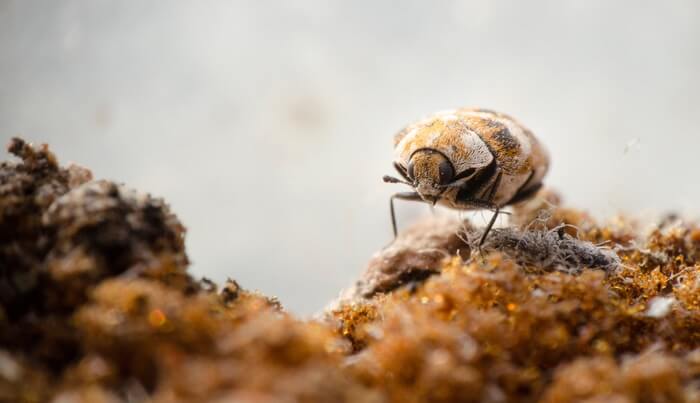
Don’t forget to get rid of bird and insect nests nearby, too. Carpet beetles will use those to build their numbers before moving into your house.
After that, consider applying an outdoor insecticide geared towards carpet beetles. Focus the application around the foundation of your home and work your way out. The best technique is to treat the soil two or three feet out from the perimeter.
Also, pay special attention to the soil around entry doors and windows.
Speaking of which, you’ll want to make sure that all entry points are solid. Repair any broken screens and plug up seals or cracks. Carpet beetles can creep into tiny nooks and crannies, so make sure to seal everything up.
Inside, it’s a good idea to vacuum and steam-clean regularly. Doing so will pick up anything that attracts these beetles and eradicate small populations as they appear. Vacuum up every discrete spot and hit underneath all furniture items.
As a preventative measure, you can sprinkle boric acid around every once in a while, too.
Quick Tip: Have clothes or linens you need to store away? Pack them up tightly in plastic bags or containers. Fully sealed vacuum bags are best, as carpet beetles can’t cut through plastic to get to your items!
Final Thoughts
Once you know how to get rid of carpet beetles these little critters shouldn’t scare you anymore. Yes, they can be a major pain. But at the end of the day, you know how to deal with them.
If you have any questions about killing or getting rid of carpet beetles that we didn’t cover in this guide, send them over. We love working with our readers and helping them navigate their pest issues!
